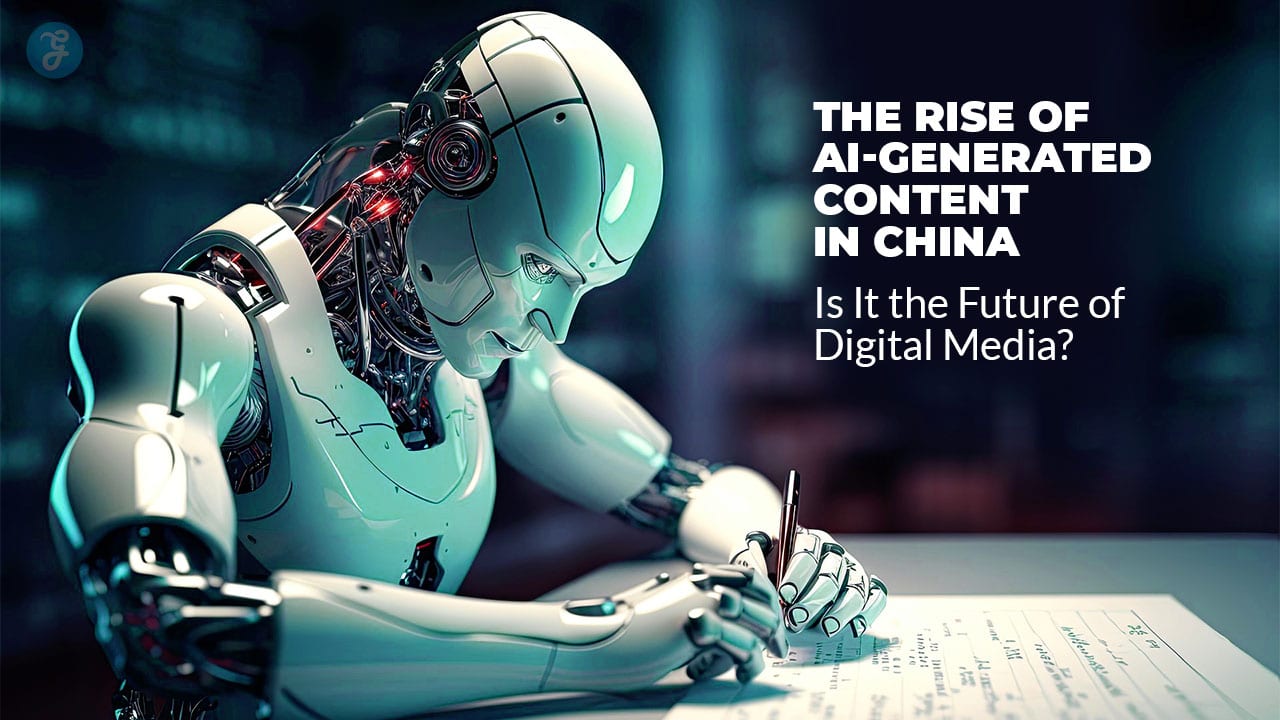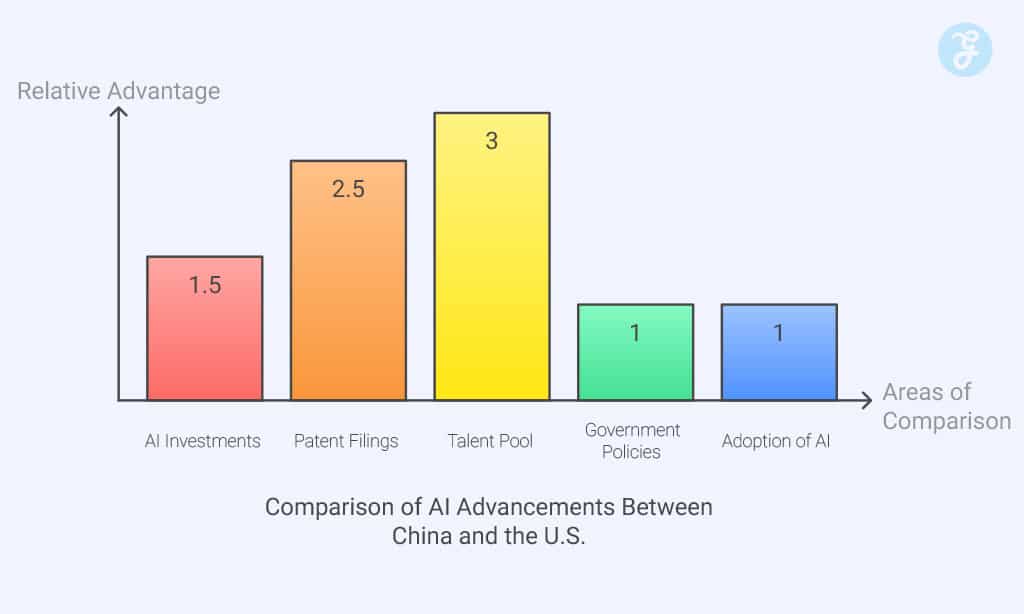AI-generated content is changing how media operates in China. Big platforms like Douyin and Baidu are driving this shift, using advanced AI tools to create content more efficiently than ever.
This means reduced costs for companies and more personalized experiences for users. But it also raises questions—can machines truly replace human creativity?
China has invested heavily in artificial intelligence (AI). Its advancements are transforming digital media globally, with its impact even extending internationally. This blog examines if AI-generated content represents the future of media—and what it could signify for creators, consumers, and industries alike.
Stay tuned!
The Growth of AI-Generated Content in China
AI-generated content is booming in China as technology changes fast. Popular apps and search engines are leading this push, reshaping digital landscapes.
Increase in adoption of generative AI tools
China is leading in generative AI innovation. Platforms like Douyin and Baidu use these tools to create more engaging content. Companies invest heavily in artificial intelligence (AI) research, with Saudi Arabia putting $400 million into Zhipu AI.
DeepSeek-R1, a Chinese large language model, costs 13 times less than OpenAI’s models for API access.
Generative AI tools play a big role in online advertising and digital marketing. News aggregators like Toutiao automate headlines at scale while boosting user engagement. Advertisers rely on these technologies to personalize ads quickly and cut down costs.
China’s focus on low-cost production has helped make advanced AI affordable across industries.
Role of platforms like Douyin and Baidu
Douyin uses AI to keep users hooked. Its advanced algorithms adapt quickly to user behavior, offering personalized content in real-time. This has fueled its growth since 2016, now outpacing competitors like Meta and YouTube Shorts.
Douyin also plays a big role in e-commerce by merging AI with social shopping models.
Baidu focuses on AI innovation for content creation and search technology. It powers tools that help businesses create accurate, fast-written articles using natural language processing (NLP).
These platforms lead China’s tech revolution while shaping how people consume digital media.
Key Technologies Driving AI-Generated Content
Advances in AI technology make content creation faster and smarter. Powerful tools now process languages, learn patterns, and create engaging material with ease.
Natural Language Processing (NLP) advancements
Transformer-based models have improved artificial intelligence (AI). These tools analyze and understand vast amounts of text data daily. Deep learning integration strengthens NLP, making it faster and more accurate.
Manual text analysis struggles with big data, often becoming slow and prone to errors.
Generative AI uses these advancements to create content quickly. Platforms like Baidu benefit from this speed for efficient updates. The growing need for precise information drives innovation in these systems.
AI technology now redefines how digital media handles complex tasks with ease.
Machine learning and deep learning integration
Machine learning and deep learning push AI-generated content forward. These technologies allow advanced tools like transformers and GANs to create images, text, audio, video, and even 3D models.
For example, platforms such as Douyin use these methods to customize user experiences based on behavior patterns.
Deep learning relies on layers of neural networks that mimic the human brain. This approach identifies trends from vast data quickly. Generative AI tools analyze user input to deliver precise results in seconds.
As a result of this integration, brands can produce targeted ads or real-time updates for internet advertising campaigns.
Applications of AI-Generated Content in Digital Media
AI is reshaping digital media with its creative abilities. It creates content fast, saving time and effort for many industries.
Automated news writing and reporting
Automated tools now write routine news stories at lightning speed. Platforms like The Associated Press and Reuters already use artificial intelligence to create financial reports. These AI tools can quickly produce thousands of articles on topics such as sports, finance, or weather updates.
They also help investigative journalism by analyzing massive datasets for trends and patterns. This frees up human reporters to focus on deeper storytelling. Such advancements in natural language processing make the technology smarter over time, improving accuracy for media content creation.
AI-driven content for entertainment and marketing
AI-generated content transforms entertainment and marketing. Tools like OpenAI’s GPT create engaging text, while DALLE produces vivid images for ads. Brands use AI innovation to analyze customer preferences.
Sentiment analysis helps companies craft relatable campaigns that connect with audiences.
Digital avatars powered by artificial intelligence (AI) star in marketing videos and social media promotions. This saves advertising professionals time and money. Generative AI provides data-driven insights, ensuring consistency across channels.
Businesses now deliver brand-consistent messages quickly and at scale.
Personalized user experiences
AI makes content unique for every user. It uses big data and machine learning to study habits, preferences, and needs. This helps create media that feels personal. Platforms like Douyin and Baidu use AI technology to suggest videos or news based on past views.
Users get exactly what they want without searching.
This tool also improves education systems by shaping lessons for students’ needs. Predictive tools enhance teaching strategies while helping learners grow faster. Instructors now guide instead of only teaching, as AI takes over repetitive tasks.
These changes show how important artificial intelligence has become in creating personalized spaces online and offline.
The Role of AI in Reshaping Media Consumption
AI is changing how people enjoy content online. It makes media more personal and interactive, creating unique experiences for each user.
Real-time customization of media content
Real-time media customization uses AI to match content with user preferences. Platforms like Douyin leverage AI technology to suggest videos based on viewing history and interests.
This process improves accessibility by delivering specific recommendations instantly. Machine learning filters huge amounts of data quickly, making media feel customized for every user.
Concerns about user privacy arise as personalization collects sensitive information. Cybersecurity laws aim to address these risks but face challenges in regulating such rapidly advancing tools.
Some formats, like live video or complex graphics, still struggle with real-time processing accuracy. Despite this, generative AI pushes boundaries in creating dynamic digital experiences.
Enhanced interactivity in digital platforms
AI tools boost interactivity on digital platforms. Platforms like Douyin use AI-generated content to keep users engaged longer. AI personalizes experiences by studying user behavior and showing customized videos or ads.
Machine learning helps create detailed consumer profiles. These profiles improve content targeting, making interactions smooth and intuitive. This approach increases purchase likelihood and builds stronger customer loyalty over time.
Societal and Ethical Implications
AI-generated content raises questions about trust and truth in digital media. It also sparks debates on jobs, creativity, and fair use in a tech-driven economy.
Concerns about misinformation and content authenticity
Generative AI makes fake news appear real. This raises doubts about what is true online. During COVID-19, false stories spread fast, causing an “infodemic.” People could not trust the information they saw.
Public health and safety were directly affected.
Misuse of AI tools can harm public trust further. Fake videos or digital avatars may mislead viewers. Such misinformation may hurt global goals like peace and strong industries. Tackling these issues is key to maintaining reliable media in the platform economy today.
Impact on human content creators
AI tools cut costs and speed up work, but they affect human creators. Many fear job loss in traditional media roles. AI can handle tasks like routine news writing or analysis of large datasets.
This lets journalists focus on deeper stories and investigative work.
Some see AI as a helpful tool, not a replacement for humans. It enhances efficiency while still needing human input for creativity and ethics. Yet, reduced demand for writers could hit gig workers hard, especially with youth unemployment already climbing in many regions, including China.
Competing Interests in the Global AI Race
China is pushing hard to lead in AI, backed by strong government investments. Its rapid progress challenges the U.S., sparking fierce competition in technology innovation and policy influence.
China’s advancements compared to the U.S.
China has emerged as a global leader in advancing artificial intelligence. The nation is outpacing the U.S. in several key areas, fueled by heavy investments and strategic government initiatives.
| Area of Comparison | China | United States |
|---|---|---|
| AI Investments | Since 2017, Chinese AI startups have attracted more investment dollars than their U.S. counterparts. | Despite significant funding, the U.S. lags behind China in total AI investments. |
| Patent Filings | By 2018, Chinese firms had filed 2.5 times more AI patents than U.S. organizations. | Fewer AI patent filings compared to China, highlighting a slower pace of innovation. |
| Talent Pool | China produces three times more computer science graduates annually, ensuring a steady supply of tech talent. | The U.S. trains fewer computer scientists each year, leading to a talent gap in AI development. |
| Government Policies | Strong state-led programs and funding drive AI innovation, aiming to dominate AI by 2030. | Relies more on private-sector innovation, with less direct government involvement. |
| Adoption of AI | Generative AI tools are widely used on platforms like Douyin and Baidu, shaping media and entertainment. | AI adoption is growing, yet platforms like YouTube and Google focus more on consumer-driven content. |
China’s focus on state support, combined with its massive talent output, gives it an edge. Its fast-paced AI adoption in industries like digital media underscores this rapid progress. Meanwhile, the U.S. leans heavily on private innovation but faces challenges in competing at this speed.
Influence of government policies and investments
The Chinese government invests heavily in artificial intelligence. It fills funding gaps for small AI firms to boost growth. These investments support AI innovation and help the country stay ahead in technology development.
The focus on digital transformation speeds up AI integration into key industries like media, manufacturing, and marketing.
U.S. export controls try to limit China’s access to advanced technology but have seen limited success. Despite such barriers, China’s efforts remain strong. Strategic investments aim to surpass the U.S., strengthening their position in the global AI race.
Government policies ensure resources flow into generative AI tools and smart manufacturing projects.
Future Prospects of AI-Generated Content in China
AI-generated content may soon power industries like education and healthcare in China. Breakthroughs in generative tools could reshape how businesses create, share, and personalize digital experiences.
Potential for transforming industries beyond media
AI technology is reshaping industries like healthcare, finance, and manufacturing. In healthcare, AI helps with medical imaging, diagnostics, and drug research. China’s AI market could surpass $1 trillion by 2030, driving innovation in these fields.
The autonomous vehicle sector is also advancing fast. By 2030, over half of Level 3 or higher driving systems may be in use across China. This shift impacts transportation services and the gig economy connected to platforms like Doordash.
Innovations on the horizon for generative AI tools
Generative AI tools in China are advancing quickly. Large language models now excel in bilingual tasks, with some surpassing U.S. systems. Developers integrate deep learning to improve accuracy and creativity in artificial intelligence (AI).
Tools can now create content faster and more personalized than ever before.
China’s government heavily funds AI innovation. Startups receive major foreign investments to push limits further. Digital avatars, like those used on platforms such as Douyin, show how far generative AI has come.
These tools promise smarter applications across industries while narrowing the gap between Chinese and U.S.-led technologies.
Takeaways
AI-generated content is changing digital media in China. It blends speed, creativity, and technology to deliver personalized experiences.
Dr. Ke Zhang, a tech expert with 15 years of AI research experience, offers insights into this shift. He holds a Ph.D. in artificial intelligence from Tsinghua University and has worked on advanced machine learning projects for top firms like Alibaba and Tencent.
Dr. Zhang points out that advancements like natural language processing make AI-driven tools powerful. They help create detailed news stories or engaging marketing ads quickly, cutting costs for companies while maintaining quality standards.
He also highlights risks linked to ethics and truthfulness. Fake news or misleading content can spread faster than before without strict checks in place. Dr. Zhang stresses the need for solid regulations and human oversight to ensure trustworthiness.
For daily use, consumers should check if these systems provide accurate information by comparing sources. Content creators may benefit from using such tools as assistants rather than full replacements.
Advantages include improved efficiency and cost-effectiveness; downsides involve potential job loss among writers or ethical concerns over originality questions—making it both exciting yet challenging territory ahead!
Dr. Zhang’s verdict: embrace innovation but with caution! Combining AI innovations alongside skilled humans could set better future benchmarks across industries worldwide!
FAQs on The Rise of AI-Generated Content in China
1. What is AI-generated content, and why is it important in China?
AI-generated content refers to text, images, or videos created by artificial intelligence (AI). In China, its importance grows as generative AI tools shape digital media through innovation in areas like news production and social platforms.
2. How does AI technology impact the workforce in China’s media industry?
AI technology automates tasks once done by people, which changes the labor force. This affects migrant labor and other workers but also creates opportunities for new skills tied to AI innovation.
3. Are there laws regulating artificial intelligence in China’s digital media sector?
Yes, China’s artificial intelligence law includes rules from organizations like the CAC that govern how AI applications are used—especially for creating safe and ethical digital content.
4. Can generative AI replace traditional forms of storytelling in Chinese media?
Generative AI can create fast and engaging stories using advanced tools like OpenAI’s models or Meta Platforms’ technologies. However, human creativity remains essential for deeper narratives.
5. How do global concerns like the social credit system tie into AI use in China’s media space?
The application of artificial intelligence connects with systems like the social credit system by analyzing data at scale—but this raises questions about privacy and fairness across industries beyond just digital media.





































